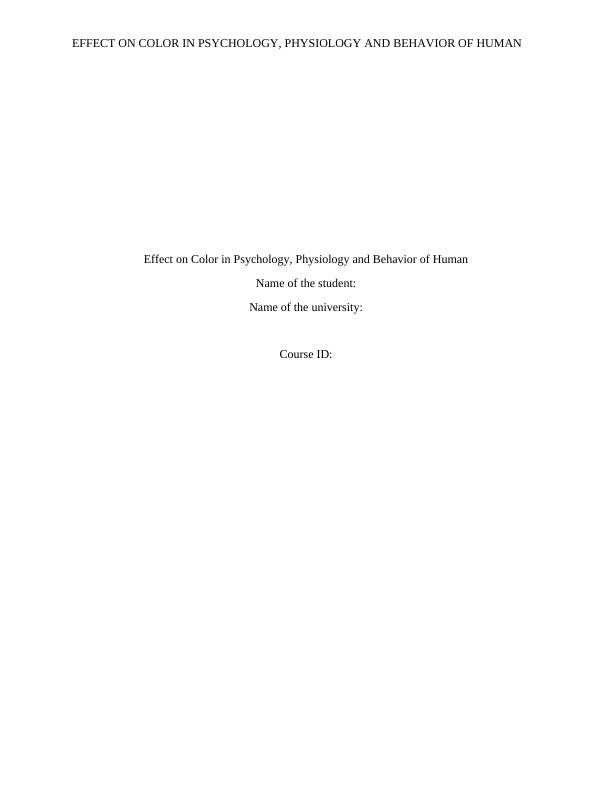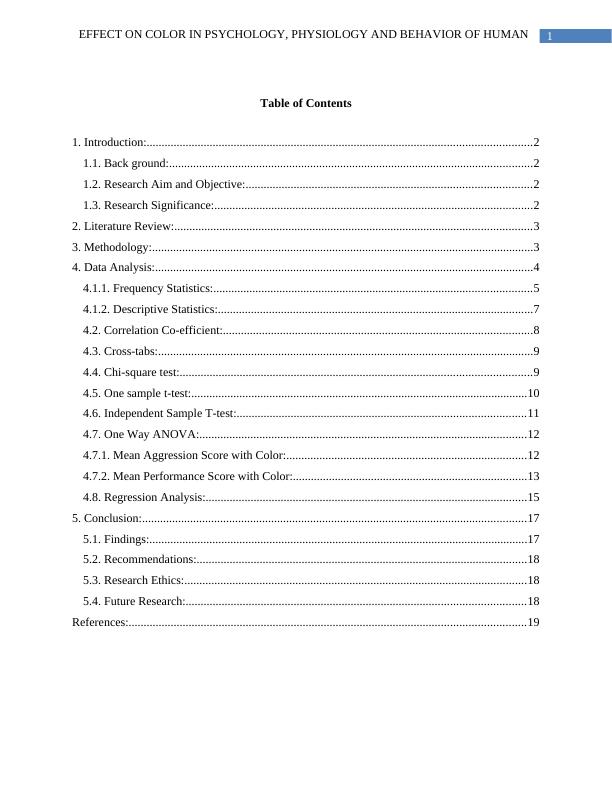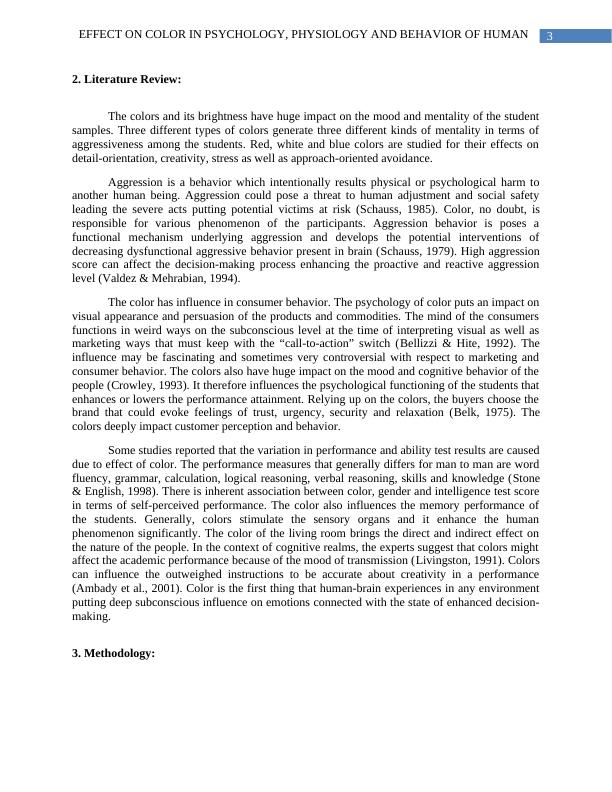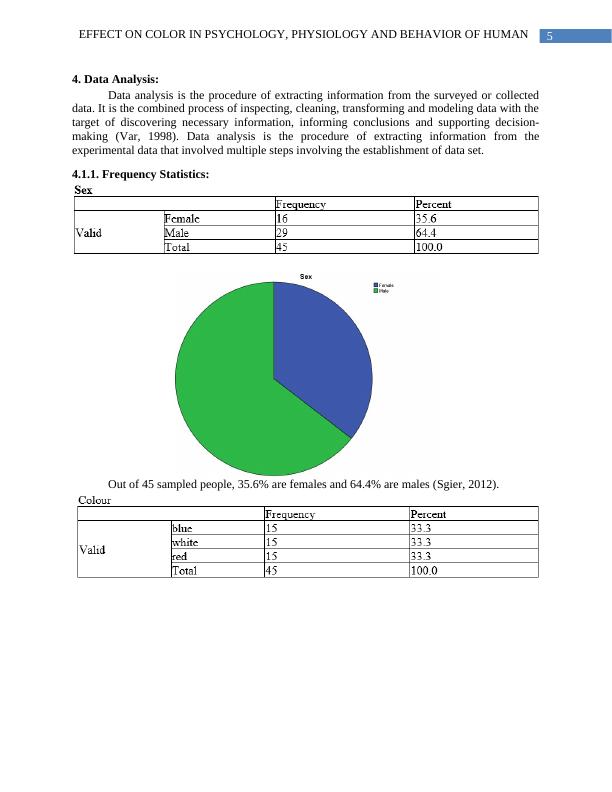Effect on Color in Psychology, Physiology and Behavior of Human
22 Pages5102 Words236 Views
Added on 2023-06-10
About This Document
This study explores the impact of color on human psychology, physiology and behavior. It analyzes the association between color and aggression score, shopping behavior and performance score. Findings suggest that color has a significant effect on human behavior. The research is conducted through an experimental method with a sample of 25 participants. The data is analyzed using various statistical tests such as descriptive statistics, cross-tabulation, chi-square test, correlation, one-way ANOVA, one sample t-test, independent sample t-test and simple linear regression.
Effect on Color in Psychology, Physiology and Behavior of Human
Added on 2023-06-10
ShareRelated Documents
EFFECT ON COLOR IN PSYCHOLOGY, PHYSIOLOGY AND BEHAVIOR OF HUMAN
Effect on Color in Psychology, Physiology and Behavior of Human
Name of the student:
Name of the university:
Course ID:
Effect on Color in Psychology, Physiology and Behavior of Human
Name of the student:
Name of the university:
Course ID:

1EFFECT ON COLOR IN PSYCHOLOGY, PHYSIOLOGY AND BEHAVIOR OF HUMAN
Table of Contents
1. Introduction:................................................................................................................................2
1.1. Back ground:.........................................................................................................................2
1.2. Research Aim and Objective:...............................................................................................2
1.3. Research Significance:..........................................................................................................2
2. Literature Review:.......................................................................................................................3
3. Methodology:...............................................................................................................................3
4. Data Analysis:..............................................................................................................................4
4.1.1. Frequency Statistics:..........................................................................................................5
4.1.2. Descriptive Statistics:.........................................................................................................7
4.2. Correlation Co-efficient:.......................................................................................................8
4.3. Cross-tabs:.............................................................................................................................9
4.4. Chi-square test:.....................................................................................................................9
4.5. One sample t-test:................................................................................................................10
4.6. Independent Sample T-test:................................................................................................11
4.7. One Way ANOVA:.............................................................................................................12
4.7.1. Mean Aggression Score with Color:................................................................................12
4.7.2. Mean Performance Score with Color:..............................................................................13
4.8. Regression Analysis:...........................................................................................................15
5. Conclusion:................................................................................................................................17
5.1. Findings:..............................................................................................................................17
5.2. Recommendations:..............................................................................................................18
5.3. Research Ethics:..................................................................................................................18
5.4. Future Research:.................................................................................................................18
References:....................................................................................................................................19
Table of Contents
1. Introduction:................................................................................................................................2
1.1. Back ground:.........................................................................................................................2
1.2. Research Aim and Objective:...............................................................................................2
1.3. Research Significance:..........................................................................................................2
2. Literature Review:.......................................................................................................................3
3. Methodology:...............................................................................................................................3
4. Data Analysis:..............................................................................................................................4
4.1.1. Frequency Statistics:..........................................................................................................5
4.1.2. Descriptive Statistics:.........................................................................................................7
4.2. Correlation Co-efficient:.......................................................................................................8
4.3. Cross-tabs:.............................................................................................................................9
4.4. Chi-square test:.....................................................................................................................9
4.5. One sample t-test:................................................................................................................10
4.6. Independent Sample T-test:................................................................................................11
4.7. One Way ANOVA:.............................................................................................................12
4.7.1. Mean Aggression Score with Color:................................................................................12
4.7.2. Mean Performance Score with Color:..............................................................................13
4.8. Regression Analysis:...........................................................................................................15
5. Conclusion:................................................................................................................................17
5.1. Findings:..............................................................................................................................17
5.2. Recommendations:..............................................................................................................18
5.3. Research Ethics:..................................................................................................................18
5.4. Future Research:.................................................................................................................18
References:....................................................................................................................................19

2EFFECT ON COLOR IN PSYCHOLOGY, PHYSIOLOGY AND BEHAVIOR OF HUMAN
1. Introduction:
1.1. Back ground:
Color is a type of visual perception and subjective sense that grows from a capability of
person, through sensory organs and to perceive the spectrum of light projected and reflected by
any object. Color vision especially sight (out of five senses) is the first reactionary elements of
design. Color is an energy that consistently influences the phenomenon physiologically and
psychologically. Color evolved unique emotion and expression among experimental samples.
It is hypothesized that color has a measurable, predictable and significant effect on
accelerating or reducing physiological, physiological and behavior factors. The effect of color
also changes from male to female in tranquilizing aggression, shopping behavior and academic
performance. Color specialists highlighted the way of changing behavior in nature in many
previous journal articles. Mainly three colors are taken into consideration that are “Blue”,
“White” and “Red”. The blue color causes loyalty, tranquility and stability. White color brings
purity, cleanliness and innocence among people whereas red color causes passion, intense and
aggression within people.
The empirical analysis perceives the preferences and choices of the students in shopping
behavior. Not only that, it highlights the aggression score and theoretical performances of the
students living in the rooms of different colors. Color controls performance of brain and it results
performance score. It properly determines the anger control levels and ideas. The experimental
research is accomplished in a controlled environment for this study that might correlated the
room of the color with aggression score, shopping behavior and performance score.
1.2. Research Aim and Objective:
It is necessary to deduce the pre-set aims and objectives of a research for conducting the
research. The objective and systematic process assist to find the solution. Applied research aims
find a solution for an immediate issue of a society or human phenomena precisely (Kothari,
2004).
The research aims are-
Do the colors have significant association with aggression score?
Do the colors have significant association with shopping behavior?
Do the colors have significant association with performance score?
This research objective is to find the inherent association between the psychological,
physiological and behavirol variables and phenomenon.
1.3. Research Significance:
The purpose of the study is to determine to differences in performance and aggression
scores between students. The focus of the study is to find the differences of human phenomena
due to colors of living rooms.
1. Introduction:
1.1. Back ground:
Color is a type of visual perception and subjective sense that grows from a capability of
person, through sensory organs and to perceive the spectrum of light projected and reflected by
any object. Color vision especially sight (out of five senses) is the first reactionary elements of
design. Color is an energy that consistently influences the phenomenon physiologically and
psychologically. Color evolved unique emotion and expression among experimental samples.
It is hypothesized that color has a measurable, predictable and significant effect on
accelerating or reducing physiological, physiological and behavior factors. The effect of color
also changes from male to female in tranquilizing aggression, shopping behavior and academic
performance. Color specialists highlighted the way of changing behavior in nature in many
previous journal articles. Mainly three colors are taken into consideration that are “Blue”,
“White” and “Red”. The blue color causes loyalty, tranquility and stability. White color brings
purity, cleanliness and innocence among people whereas red color causes passion, intense and
aggression within people.
The empirical analysis perceives the preferences and choices of the students in shopping
behavior. Not only that, it highlights the aggression score and theoretical performances of the
students living in the rooms of different colors. Color controls performance of brain and it results
performance score. It properly determines the anger control levels and ideas. The experimental
research is accomplished in a controlled environment for this study that might correlated the
room of the color with aggression score, shopping behavior and performance score.
1.2. Research Aim and Objective:
It is necessary to deduce the pre-set aims and objectives of a research for conducting the
research. The objective and systematic process assist to find the solution. Applied research aims
find a solution for an immediate issue of a society or human phenomena precisely (Kothari,
2004).
The research aims are-
Do the colors have significant association with aggression score?
Do the colors have significant association with shopping behavior?
Do the colors have significant association with performance score?
This research objective is to find the inherent association between the psychological,
physiological and behavirol variables and phenomenon.
1.3. Research Significance:
The purpose of the study is to determine to differences in performance and aggression
scores between students. The focus of the study is to find the differences of human phenomena
due to colors of living rooms.

3EFFECT ON COLOR IN PSYCHOLOGY, PHYSIOLOGY AND BEHAVIOR OF HUMAN
2. Literature Review:
The colors and its brightness have huge impact on the mood and mentality of the student
samples. Three different types of colors generate three different kinds of mentality in terms of
aggressiveness among the students. Red, white and blue colors are studied for their effects on
detail-orientation, creativity, stress as well as approach-oriented avoidance.
Aggression is a behavior which intentionally results physical or psychological harm to
another human being. Aggression could pose a threat to human adjustment and social safety
leading the severe acts putting potential victims at risk (Schauss, 1985). Color, no doubt, is
responsible for various phenomenon of the participants. Aggression behavior is poses a
functional mechanism underlying aggression and develops the potential interventions of
decreasing dysfunctional aggressive behavior present in brain (Schauss, 1979). High aggression
score can affect the decision-making process enhancing the proactive and reactive aggression
level (Valdez & Mehrabian, 1994).
The color has influence in consumer behavior. The psychology of color puts an impact on
visual appearance and persuasion of the products and commodities. The mind of the consumers
functions in weird ways on the subconscious level at the time of interpreting visual as well as
marketing ways that must keep with the “call-to-action” switch (Bellizzi & Hite, 1992). The
influence may be fascinating and sometimes very controversial with respect to marketing and
consumer behavior. The colors also have huge impact on the mood and cognitive behavior of the
people (Crowley, 1993). It therefore influences the psychological functioning of the students that
enhances or lowers the performance attainment. Relying up on the colors, the buyers choose the
brand that could evoke feelings of trust, urgency, security and relaxation (Belk, 1975). The
colors deeply impact customer perception and behavior.
Some studies reported that the variation in performance and ability test results are caused
due to effect of color. The performance measures that generally differs for man to man are word
fluency, grammar, calculation, logical reasoning, verbal reasoning, skills and knowledge (Stone
& English, 1998). There is inherent association between color, gender and intelligence test score
in terms of self-perceived performance. The color also influences the memory performance of
the students. Generally, colors stimulate the sensory organs and it enhance the human
phenomenon significantly. The color of the living room brings the direct and indirect effect on
the nature of the people. In the context of cognitive realms, the experts suggest that colors might
affect the academic performance because of the mood of transmission (Livingston, 1991). Colors
can influence the outweighed instructions to be accurate about creativity in a performance
(Ambady et al., 2001). Color is the first thing that human-brain experiences in any environment
putting deep subconscious influence on emotions connected with the state of enhanced decision-
making.
3. Methodology:
2. Literature Review:
The colors and its brightness have huge impact on the mood and mentality of the student
samples. Three different types of colors generate three different kinds of mentality in terms of
aggressiveness among the students. Red, white and blue colors are studied for their effects on
detail-orientation, creativity, stress as well as approach-oriented avoidance.
Aggression is a behavior which intentionally results physical or psychological harm to
another human being. Aggression could pose a threat to human adjustment and social safety
leading the severe acts putting potential victims at risk (Schauss, 1985). Color, no doubt, is
responsible for various phenomenon of the participants. Aggression behavior is poses a
functional mechanism underlying aggression and develops the potential interventions of
decreasing dysfunctional aggressive behavior present in brain (Schauss, 1979). High aggression
score can affect the decision-making process enhancing the proactive and reactive aggression
level (Valdez & Mehrabian, 1994).
The color has influence in consumer behavior. The psychology of color puts an impact on
visual appearance and persuasion of the products and commodities. The mind of the consumers
functions in weird ways on the subconscious level at the time of interpreting visual as well as
marketing ways that must keep with the “call-to-action” switch (Bellizzi & Hite, 1992). The
influence may be fascinating and sometimes very controversial with respect to marketing and
consumer behavior. The colors also have huge impact on the mood and cognitive behavior of the
people (Crowley, 1993). It therefore influences the psychological functioning of the students that
enhances or lowers the performance attainment. Relying up on the colors, the buyers choose the
brand that could evoke feelings of trust, urgency, security and relaxation (Belk, 1975). The
colors deeply impact customer perception and behavior.
Some studies reported that the variation in performance and ability test results are caused
due to effect of color. The performance measures that generally differs for man to man are word
fluency, grammar, calculation, logical reasoning, verbal reasoning, skills and knowledge (Stone
& English, 1998). There is inherent association between color, gender and intelligence test score
in terms of self-perceived performance. The color also influences the memory performance of
the students. Generally, colors stimulate the sensory organs and it enhance the human
phenomenon significantly. The color of the living room brings the direct and indirect effect on
the nature of the people. In the context of cognitive realms, the experts suggest that colors might
affect the academic performance because of the mood of transmission (Livingston, 1991). Colors
can influence the outweighed instructions to be accurate about creativity in a performance
(Ambady et al., 2001). Color is the first thing that human-brain experiences in any environment
putting deep subconscious influence on emotions connected with the state of enhanced decision-
making.
3. Methodology:

4EFFECT ON COLOR IN PSYCHOLOGY, PHYSIOLOGY AND BEHAVIOR OF HUMAN
The analysis is exploratory in nature. Exploratory research is conducted that results
clearer, intended and prior establishment of the study (Behrens & Yu, 2003). It also develops
operational definitions and enhance the final research design (Cox, 2017).
It is also an experimental research study that intend to make the cause and effect
statements typically using experimental research not necessarily conducted in an experimental
research (Quinn & Keough, 2002). Such types of experimental method determine the best
research design, data-collection process and selection of the theme of the project. The data of the
research is collected in the experimental method. The researcher conducted two tests on exam
performance and aggression outputs. The observed physiological, physiological and behavioral
measures are aggression score, shopping behavior and academic performance score. The sample
of 25 participants are considered in this regard.
The data analysis is simultaneously both quantitative and qualitative in nature (Bryman,
2006). Some of the variables like age, aggression score, stimulation level or performance score
are numerical in nature. On the other hand, some variables like sex, color and buying behavior
are categorical in nature. The data is collected in replicated way. Hence, the data set is not cross
sectional. The analysis simultaneously gender-wise finds the impact of color on aggression score,
shopping behavior and performance score. The colors chosen for the experiment are- red, white
and blue. The principle of choosing color is occurred in a conscious level as per suggested to the
researcher. The choice of color is carried out in the way of color of products, taking into account
the potential benefits and effectiveness. Experiments and testing of the control groups are
designed for supporting producers, managers, designers and advertisers.
The stimulating level is measured in the scale of 0 to 10. The aggression score is
measured is the scale 40 to 210. The performance score is measured in the scale 0 to 100.
Moreover, the color preference experiments are performed on similar subjects (replication). The
experiments are observed thoroughly and results are tabulated in the “Observational Method”
(Mann, 2003). It is a type of procedure that have strengths and weaknesses simultaneously of any
action or behavior of the participants involving in psychological research. The method involves
the “direct observation of phenomena” as per their natural setting. The data set are collected after
keeping 25 participants in the rooms of three different colors for more than 6 months. The
aggression scores, shopping behavior and performances are tabulated including more or less
equal level of stimulating level. The statistical analyses and tests carried out in this analysis are-
Descriptive statistics
Cross tabulation
Chi-square test
Correlation
One-way ANOVA
One sample or single sample t-test
Independent sample t-test
Simple Linear Regression
The data is analyzed with the help of SPSS-20 software. This statistical package easily
and properly executes tables and graphs.
The analysis is exploratory in nature. Exploratory research is conducted that results
clearer, intended and prior establishment of the study (Behrens & Yu, 2003). It also develops
operational definitions and enhance the final research design (Cox, 2017).
It is also an experimental research study that intend to make the cause and effect
statements typically using experimental research not necessarily conducted in an experimental
research (Quinn & Keough, 2002). Such types of experimental method determine the best
research design, data-collection process and selection of the theme of the project. The data of the
research is collected in the experimental method. The researcher conducted two tests on exam
performance and aggression outputs. The observed physiological, physiological and behavioral
measures are aggression score, shopping behavior and academic performance score. The sample
of 25 participants are considered in this regard.
The data analysis is simultaneously both quantitative and qualitative in nature (Bryman,
2006). Some of the variables like age, aggression score, stimulation level or performance score
are numerical in nature. On the other hand, some variables like sex, color and buying behavior
are categorical in nature. The data is collected in replicated way. Hence, the data set is not cross
sectional. The analysis simultaneously gender-wise finds the impact of color on aggression score,
shopping behavior and performance score. The colors chosen for the experiment are- red, white
and blue. The principle of choosing color is occurred in a conscious level as per suggested to the
researcher. The choice of color is carried out in the way of color of products, taking into account
the potential benefits and effectiveness. Experiments and testing of the control groups are
designed for supporting producers, managers, designers and advertisers.
The stimulating level is measured in the scale of 0 to 10. The aggression score is
measured is the scale 40 to 210. The performance score is measured in the scale 0 to 100.
Moreover, the color preference experiments are performed on similar subjects (replication). The
experiments are observed thoroughly and results are tabulated in the “Observational Method”
(Mann, 2003). It is a type of procedure that have strengths and weaknesses simultaneously of any
action or behavior of the participants involving in psychological research. The method involves
the “direct observation of phenomena” as per their natural setting. The data set are collected after
keeping 25 participants in the rooms of three different colors for more than 6 months. The
aggression scores, shopping behavior and performances are tabulated including more or less
equal level of stimulating level. The statistical analyses and tests carried out in this analysis are-
Descriptive statistics
Cross tabulation
Chi-square test
Correlation
One-way ANOVA
One sample or single sample t-test
Independent sample t-test
Simple Linear Regression
The data is analyzed with the help of SPSS-20 software. This statistical package easily
and properly executes tables and graphs.

5EFFECT ON COLOR IN PSYCHOLOGY, PHYSIOLOGY AND BEHAVIOR OF HUMAN
4. Data Analysis:
Data analysis is the procedure of extracting information from the surveyed or collected
data. It is the combined process of inspecting, cleaning, transforming and modeling data with the
target of discovering necessary information, informing conclusions and supporting decision-
making (Var, 1998). Data analysis is the procedure of extracting information from the
experimental data that involved multiple steps involving the establishment of data set.
4.1.1. Frequency Statistics:
Out of 45 sampled people, 35.6% are females and 64.4% are males (Sgier, 2012).
4. Data Analysis:
Data analysis is the procedure of extracting information from the surveyed or collected
data. It is the combined process of inspecting, cleaning, transforming and modeling data with the
target of discovering necessary information, informing conclusions and supporting decision-
making (Var, 1998). Data analysis is the procedure of extracting information from the
experimental data that involved multiple steps involving the establishment of data set.
4.1.1. Frequency Statistics:
Out of 45 sampled people, 35.6% are females and 64.4% are males (Sgier, 2012).

End of preview
Want to access all the pages? Upload your documents or become a member.
Related Documents
Introduction to Psychology : Assignmentlg...
|15
|3915
|220
Scientific Method, Correlation and Experimental Research, Naturalistic Observation, and Psychological Researchlg...
|2
|798
|148
A Study of Congruence and Semantic Relatedness in the Stroop Effectlg...
|12
|3110
|458
Huge Two Meta traits – Reconnoitring the Relationship with Creative Self-Concept and Performance on Creativity Taskslg...
|20
|4878
|422
Leukaemia In Children AGED 6-12 YEARS IN EUROPElg...
|14
|2820
|364
Effect of Ageing on Memory Retention: A Study on Younger and Older Adultslg...
|19
|4106
|264
